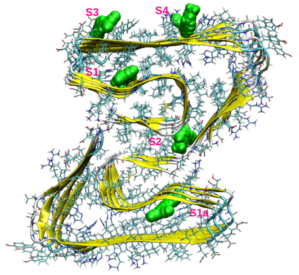Content #1
Content #1
Content #1
To better manage Alzheimer’s disease, early diagnosis and monitoring are crucial. Current diagnostic tools like PET-based amyloid imaging tracers have limitations of low binding specificity, and treatments of FDA-approved drugs have high costs and only treat symptoms. Such limitations prompt the need for better optical probes with high binding specificity and affinity for in vivo imaging of the amyloid and tau fibrils responsible for such neurodegenerative diseases. In vivo imaging agents, often radiolabeled, help visualize fibril distribution in the brain, such as two-photon probes which can image deep tissues and internal organs. These probes absorb infrared (IR) and near-IR light and have significant two-photon absorption cross sections. The DANIR-2c probe (also known as DCDAPH) is a donor-acceptor-substituted molecule that has been used for in vivo detection of β-amyloid deposits using fluorescence spectroscopy.
In a 2023 publication in The Journal of Physical Chemistry B, N. Arul Murugan and Robert Zaleśny employed a multiscale computational approach using multiple techniques to study the binding of DANIR-2c to amyloid fibrils and its one- and two-photon absorption properties within the fibrillar environment. The researchers found that DANIR-2c had high binding affinity and significant two-photon absorption, making it a promising candidate for two-photon imaging of amyloid fibrils with the probe’s multiple binding sites.
The site on the probe with the highest binding affinity also showed the most significant two-photon absorption cross section necessary for imaging applications, highlighting its potential benefits in two-photon microscopy over other probes such as Thioflavin-T (ThT), a known amyloid staining molecule. The successful modeling of DANIR-2c binding to amyloid fibrils and its superior two-photon absorption underscore the potential of similar two-photon probes for validating drug candidates and monitoring fibril accumulation in animal models. Such probes are also cost-effective and may be adapted for in vivo PET imaging, thereby enhancing diagnostic capabilities and contributing to the fight against Alzheimer’s and other neurodegenerative diseases.

Visit the product page for DCDAPH (DANIR-2c), and explore our other products for neuroscience research.
Full Citation
Arul Murugan, Robert Zaleśny. Computational Investigations into Two-Photon Fibril Imaging Using the DANIR-2c Probe. J. Phys. Chem. B, 127, 14, 3119–3125 (2023). https://doi.org/10.1021/acs.jpcb.2c07783